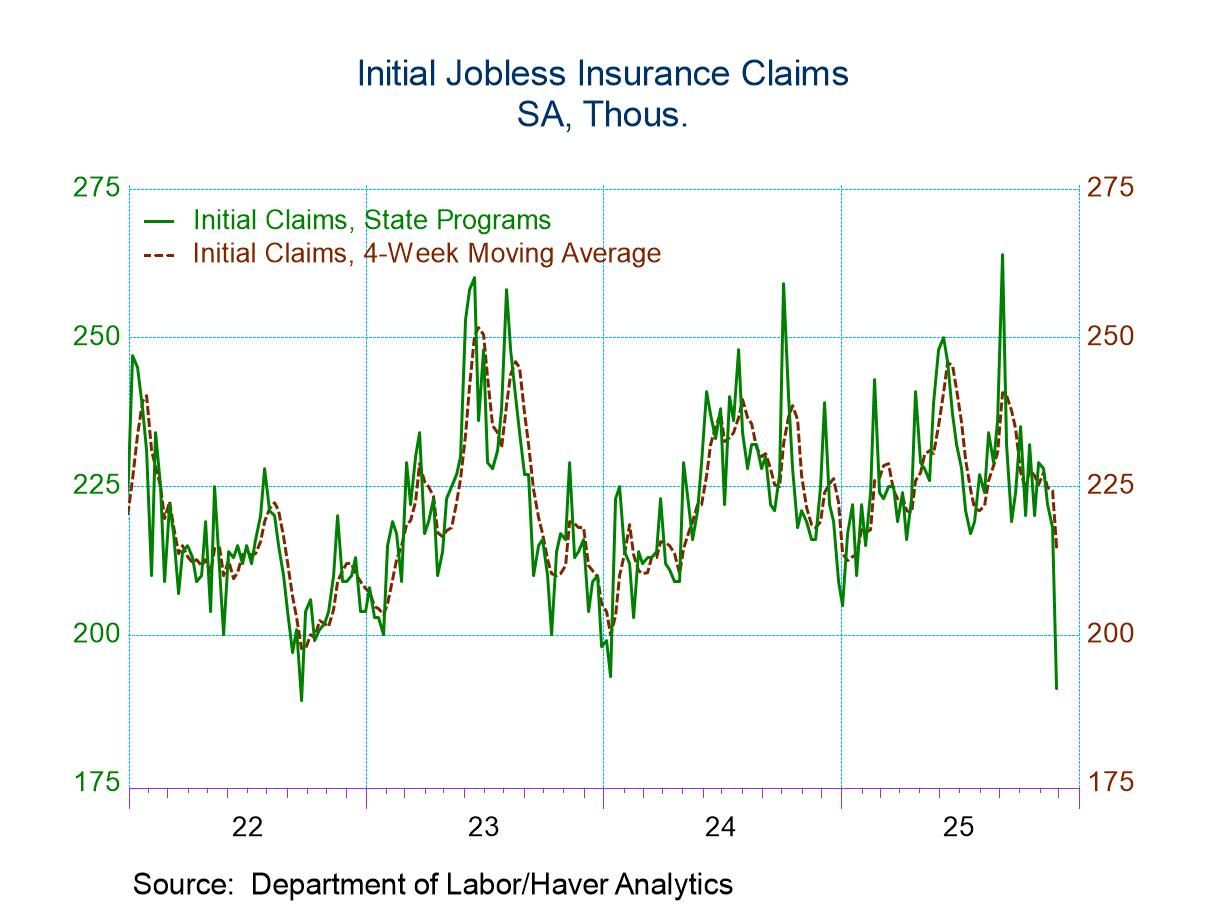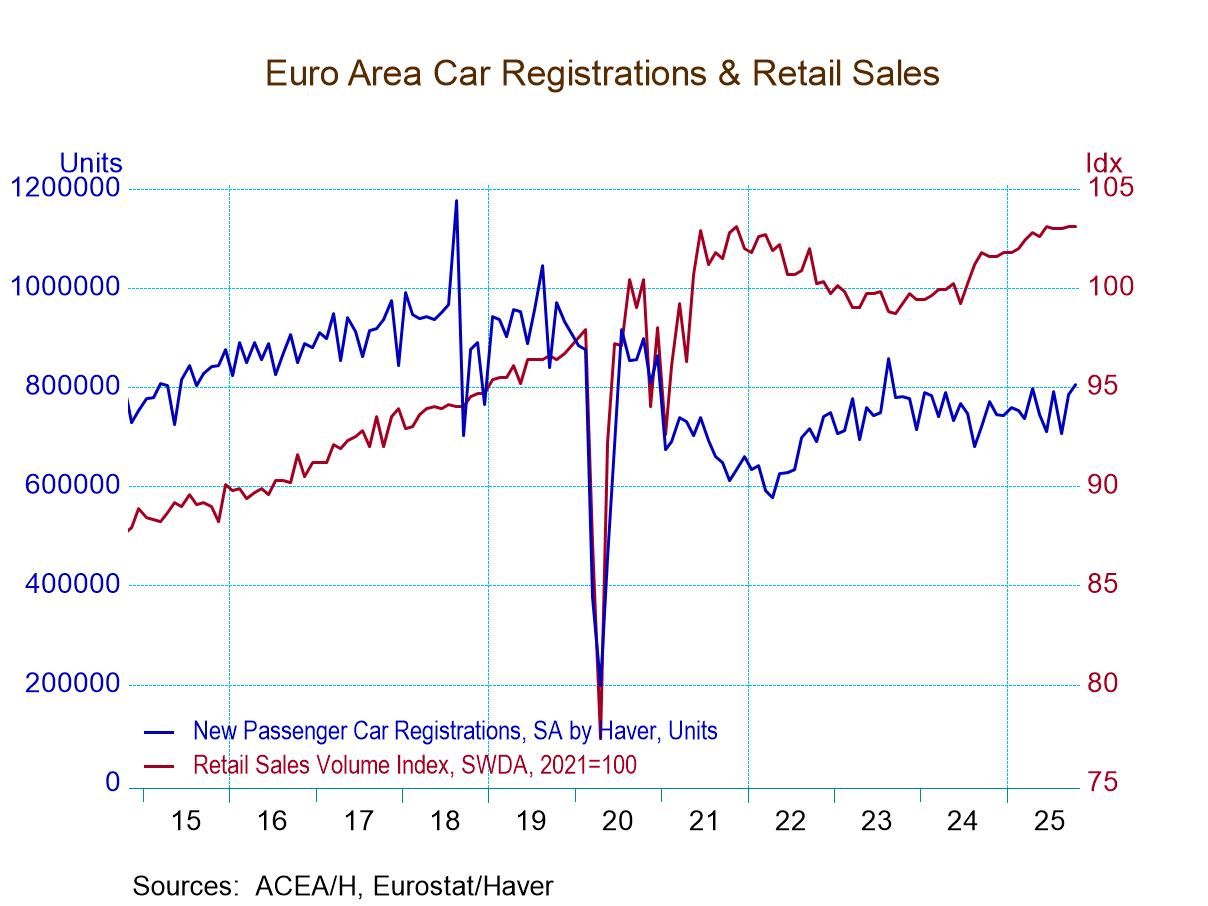 Global| Dec 22 2014
Global| Dec 22 2014U.S. Existing Home Sales and Prices Decline
by:Tom Moeller
|in:Economy in Brief
Summary
Existing single-family home sales fell 6.1% last month to 4.930 million (AR) versus 5.250 in October, revised from 5.260 million. Sales were 8.4% below their July 2003 high and well short of consensus expectations for 5.20 million in [...]
Tom Moeller December 22, 2014
Existing single-family home sales fell 6.1% last month to 4.930 million (AR) versus 5.250 in October, revised from 5.260 million. Sales were 8.4% below their July 2003 high and well short of consensus expectations for 5.20 million in the Action Economics Forecast Survey. Single-family home sales declined 6.3% to 4.330 million. Condo and co-op sales were off 4.8% to 0.600 million (0.0% y/y).
The median sales price of an existing home declined 1.0% to $205,300 (+5.0% y/y) from $207,500, revised from $208,300. This was the fifth consecutive monthly decline, usual for the recent five months in years past. The median price declined 0.9% (+5.6% y/y), also the fifth straight month of decline.
By region, sales in the West declined 9.6% to 1.030 million (-1.0% y/y). Sales in the Midwest were off 8.9% to 1.130 million (-1.7% y/y) and sales fell 3.2% to 2.090 million in the South (+5.0% y/y). Sales in the Northeast declined 4.2% to 680,000 (+4.6% y/y).
The inventory of unsold homes increased 2.0% y/y to 2.090 million. Compared to sales, this supply of unsold homes held at 5.1 months. That compares to an 11.9-month peak supply in July of 2010.
During October, home affordability slipped 0.4% (-1.7% y/y). Monthly mortgage payments nudged up to 15.1% of median family income but remained down from their recent high of 16.1%. Mortgage interest rates rose to 4.29% from 4.21% but remained below the recent high of 4.54% in January.
The data on existing home sales, prices and affordability can be found in Haver's USECON database. The regional price, affordability and inventory data are available in the REALTOR database. The expectations figure is from the Action Economics survey, reported in the AS1REPNA database.
| Existing Home Sales (SAAR, 000s) | Nov | Oct | Sep | Y/Y % | 2013 | 2012 | 2011 |
|---|---|---|---|---|---|---|---|
| Total | 4,930 | 5,250 | 5,180 | 2.1 | 5,073 | 4,659 | 4,277 |
| Northeast | 680 | 710 | 690 | 4.6 | 659 | 597 | 543 |
| Midwest | 1,130 | 1,240 | 1,180 | -1.7 | 1,193 | 1,064 | 917 |
| South | 2,090 | 2,160 | 2,110 | 5.0 | 2,032 | 1,834 | 1,683 |
| West | 1,030 | 1,140 | 1,200 | -1.0 | 1,190 | 1,164 | 1,133 |
| Single-Family Sales | 4,330 | 4,620 | 4,570 | 2.4 | 4,471 | 4,128 | 3,792 |
| Median Price Total ($, NSA) | 205,300 | 207,500 | 209,100 | 5.0 | 195,667 | 175,442 | 164,542 |
Chicago Fed National Activity Index Reaches Expansion
High
by Tom Moeller December
22, 2014
The Chicago Federal Reserve reported that its National Activity Index (CFNAI) for November improved to 0.73 from 0.31 during October, revised from 0.14. It was the highest level since December, 2006. The three-month moving average rose to 0.48, its highest point since May, 2010. During the last ten years, there has been a 75% correlation between the Chicago Fed Index and the q/q change in real GDP.
The driver for the increase was the Production & Income component rising to 0.64, its highest level since May, 2010. The Personal Consumption & Housing series held fairly steady at -0.10. The remaining components eased. The Sales, Orders & Inventories series backpedaled to 0.02. The Employment, Unemployment & Hours figure worked lower to 0.17.
The CFNAI is a weighted average of 85 indicators of national economic activity. It is constructed to have an average value of zero and a standard deviation of one. Since economic activity tends toward trend growth rate over time, a positive index reading corresponds to growth above trend and a negative index reading corresponds to growth below trend.
The Chicago Federal Reserve figures are available in Haver's SURVEYS database.
Declining Labor Force Participation and Its Implications for Unemployment and Employment Growth from the Federal Reserve Bank of Chicago can be found here www.chicagofed.org/~/media/publications/economic-perspectives/2014/4q2014-part1-aaronson-etal-pdf.pdf
| Chicago Federal Reserve Bank | Nov | Oct | Sep | Nov'13 | 2013 | 2012 | 2011 |
|---|---|---|---|---|---|---|---|
| CFNAI | 0.73 | 0.31 | 0.38 | 0.70 | -0.01 | -0.05 | -0.07 |
| 3-Month Moving Average | 0.48 | 0.09 | 0.17 | 0.35 | -- | -- | -- |
| Personal Consumption & Housing | -0.10 | -0.11 | -0.15 | -0.07 | -0.15 | -0.20 | -0.29 |
| Employment, Unemployment & Hours | 0.17 | 0.22 | 0.22 | 0.38 | 0.09 | 0.09 | 0.13 |
| Production & Income | 0.64 | 0.09 | 0.26 | 0.15 | 0.03 | 0.06 | 0.04 |
| Sales, Orders & Inventories | 0.02 | 0.11 | 0.05 | 0.24 | 0.03 | -0.00 | 0.03 |
Tom Moeller
AuthorMore in Author Profile »Prior to joining Haver Analytics in 2000, Mr. Moeller worked as the Economist at Chancellor Capital Management from 1985 to 1999. There, he developed comprehensive economic forecasts and interpreted economic data for equity and fixed income portfolio managers. Also at Chancellor, Mr. Moeller worked as an equity analyst and was responsible for researching and rating companies in the economically sensitive automobile and housing industries for investment in Chancellor’s equity portfolio. Prior to joining Chancellor, Mr. Moeller was an Economist at Citibank from 1979 to 1984. He also analyzed pricing behavior in the metals industry for the Council on Wage and Price Stability in Washington, D.C. In 1999, Mr. Moeller received the award for most accurate forecast from the Forecasters' Club of New York. From 1990 to 1992 he was President of the New York Association for Business Economists. Mr. Moeller earned an M.B.A. in Finance from Fordham University, where he graduated in 1987. He holds a Bachelor of Arts in Economics from George Washington University.






